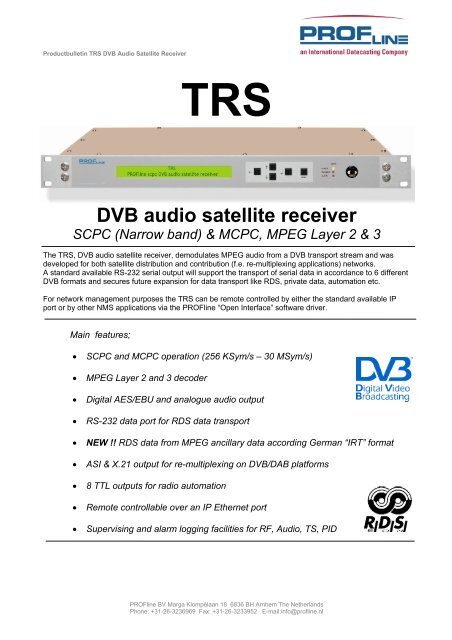DVB Output
DVB-T2 is the successor standard of DVB-T, which allows more programs in a higher image quality, but it is not backwards compatible with DVB-T. DVB-S and DVB-S2. DVB-S stands for digital satellite TV. Here, the TV is broadcasted through a satellite and then lands on the satellite dish on the roof and via a DVB-S receiver in the living room. DVB-T/T2 Input with 4x receivers, 47 - 862 MHz. 1k (T2), 2k, 4k (T2) 8k, 16k (T2) and 32k (T2) carrier modes. QPSK, 16QAM, 64QAM,128QAM (T2) and 256QAM (T2). High-Performance Streaming DVBlast is written to be the core of a custom IRD, CID, or ASI gateway, based on a PC with a Linux-supported card. It is very lightweight and stable, designed for 24/7 operation. DVBlast does not do any kind of processing on the elementary streams, such as transcoding, or remultiplexing.
ECEN 4242 - Communication Standards Survey
Typical Applications
Frequency Band
Block Diagram
Error Control Coding
Constellations
I/Q
Multi-Access
References
Introduction
Digital Video Broadcasting - Satellite Generation 2 (DVB-S2, EN 302 307) is a digital satellite transmission system developed by the DVB Project. It makes use of the latest modulation and coding techniques to deliver performance that approaches the theoretical limit for such systems. Satellite transmission was the first area addressed by the DVB Project in 1993 and DVB standards form the basis of most satellite DTV services around the world today, and therefore of most digital TV in general. DVB-S2 will not replace DVB-S in the short or even the medium term, but makes possible the delivery of services that could never have been delivered using DVB-S, and does so with a performance level that ensures that we won’t see a “DVB-S3” for a very long time, if ever!

DVB-S2 is not currently implemented. The conversion process from DVB-S to DVB-S2 is expected to take about 15 years—probably in sync with the coming of HDTV. DVB-S has proven to be a well designed and flexible standard, and this makes the upgrade process take longer for those delivering programming.
Typical Applications
Envisaged scenarios for DVB-S2 by the standard document are:

Frequency Band

Standard Body
The standard body is the European Telecommunications Standards Institute (ETSI). More information can be found at the etsi site
The Digital Video Broadcasting (DVB) Project is an industry-led consortium of over 250 broadcasters, manufacturers, network operators, software developers, regulatory bodies and others in over 35 countries committed to designing open interoperable standards for the global delivery of digital media services. As DVB’s name suggests, these include broadcasting. Services using DVB standards are available on every continent with more than 500 million DVB receivers deployed.

Block Diagram
Error Control Coding
Forward Error Correction (FEC) Encoding shall be carried out by the concatenation of BCH outer codes and LDPC (Low Density Parity Check) inner codes (rates 1/4, 1/3, 2/5, 1/2, 3/5, 2/3, 3/4, 4/5, 5/6, 8/9, 9/10) to achieve quasi-error free (QEF) reception conditions on an AWGN channel.
Depending on the application area, the FEC coded block shall have length nldpc = 64 800 bits or 16 200 bits. When VCM and ACM is used, FEC and modulation mode may be changed in different frames, but remains constant within a frame. For Backwards Compatible modes, the bit-stream at the output of the FEC encoder shall be processed according to annex F. Bit interleaving shall be applied to FEC coded bits for 8PSK, 16APSK and 32APSK.
Format of data before bit interleaving. nldpc=64800 bits for normal FECFRAME, nldpc=16200 bits for short FECFRAME
Constellations
Possible Constellations are:QPSK and 8PSK are typically proposed for broadcast applications, since they are virtually constant envelope modulations and can be used in non-linear satellite transponders driven near saturation. For some specific broadcasting applications (i.e. regional spot beams) and interactive application operating with multi-beam satellites, 16APSK provides extra spectral efficiency with very limited linearity requirements if proper pre-distortion schemes are employed.
32APSK modes, mainly targeted to professional applications, can also be used for broadcasting, but these require a higher level of available C/N and the adoption of advanced pre-distortion methods in the up-link station to minimize the effect of transponder non-linearity. While these modes are not as power efficient as the other modes, the data throughput is much greater. 16APSK and 32APSK constellations have been optimized to operate over a non-linear transponder by placing the points on circles. Nevertheless their performances on a linear channel are comparable with those of 16QAM and 32QAM respectively.
Dvb Outputs
All the modes are also appropriate for operation in quasi-linear satellite channels, in multi-carrier Frequency Division Multiplex (FDM) type applications.
I/Q
After randomization, the signals are be square root raised cosine filtered with roll-off factors a = 0,35, 0,25 and 0,20, depending on the service requirements.
Dvb Output Calculator
The baseband square root raised cosine filter isdefined by the following expression:
Information found in ETSC 302 307
Quadrature modulation shall be performed by multiplying the in-phase and quadrature samples (after baseband filtering) by sin (2pf0t) and cos (2pf0t), respectively (where f0 is the carrier frequency). The two resulting signals are added to obtain the modulator output signal. The specific I/Q parts of the signal could not be determined at this time.
TBS690B Quad DVB ASI Output Transmit PCIe Card
Multi-Access
See Full List On Linuxtv.org
The DVB-S2 system may be used in 'single carrier per transponder' or in 'multi-carriers per transponder' (FDM) configurations.
References
DVB-S2 fact sheet
Wikipedia
ETSI EN 302 307
ETSI TR 102 376
